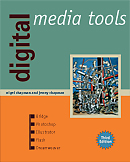
See the book at amazon.co.uk or amazon.com
Related Books

See Digital Multimedia at amazon.co.uk or amazon.com

See Web Design: A Complete Introduction at amazon.co.uk or amazon.com
The authors are not responsible for the content of any external sites linked to from digitalmediatools.org
All material on this site is ©2007–2010 MacAvon Media and may not be reproduced without permission.
Photoshop Teaching Notes
It is something of a cliché that every Photoshop user only uses about 20% of the program's features, but that each one uses a different 20%. The number is pulled out of thin air, but the underlying observation is undoubtedly true. For most people, Photoshop is something that is used as a step along the way to something else: Web designers may use it to prepare an image for the Web, animators may use it to prepare artwork for individual frames, motion graphic designers may use it for altering frames of video. Even people who are using Photoshop as an end in itself, such as photographers preparing images for print or digital artists creating images from scratch, may only be interested in a small part of what the program can do.
It follows that the best way of teaching Photoshop will depend on the context in which it is being taught. It is unlikely that you will want to cover in detail everything that is included in this chapter. On the assumption that the book will be used as a companion to Web Design, we have placed the information needed by Web designers who simply want to be able to open an image and save it for the Web at the beginning of the chapter. Animators will find material of special interest to them at the end. Almost everybody will need to know how to perform basic adjustments, such as levels and colour balance adjustments. (Shadows/Highlights is probably the most useful single adjustment, if you do not have time to cover all the adjustments in detail.) You should choose how much of the rest to include, depending on what sort of tasks your students will need to do, although you might consider describing some things, such as the Vanishing Point filter, just because they are fun.
You will have to include the material about colour from Chapter 8 fairly early on, unless you have dealt with it already in a different context, because so much of what you might want to do in Photoshop is concerned with colour.
The use of brushes of different sorts controlled by precise cursor movements means that the warnings about RSI included in the introduction are particularly relevant to this chapter, and you should make sure that students are fully aware of the risks. Do everything you can to encourage them to work in a safe way and reduce the risk of long-term injury.